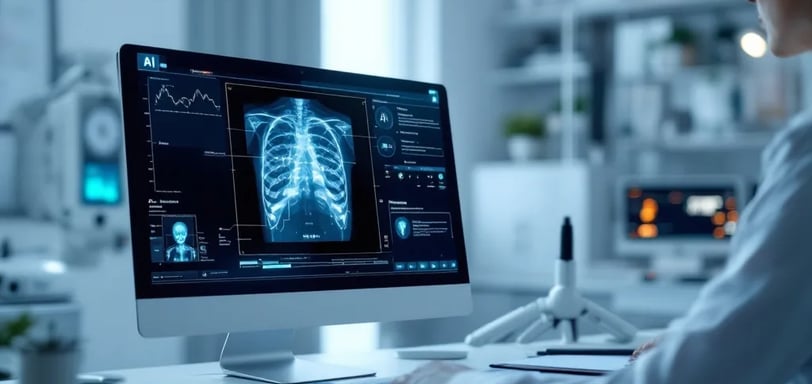How AI is Transforming X-Ray Image Interpretation
Artificial Intelligence (AI) is no longer just a buzzword — it’s revolutionizing the healthcare industry, particularly in the field of medical imaging. Among the most significant advancements is AI’s role in enhancing X-ray image interpretation. X-ray imaging is one of the most commonly used diagnostic tools, offering critical insights into a patient's health. However, interpreting X-ray images can be complex, requiring high levels of expertise and experience. Here’s how AI is transforming X-ray image interpretation, making the process faster, more accurate, and more efficient.
3/22/20255 min read


What is AI in X-Ray Image Interpretation?
AI, particularly machine learning (ML) and deep learning, involves training algorithms to analyze medical images. In the case of X-rays, AI systems are trained on large datasets of X-ray images to recognize patterns, detect abnormalities, and offer diagnostic suggestions. Over time, these AI systems can learn from vast amounts of data, improving their ability to detect subtle anomalies that may be overlooked by the human eye.
AI’s role in X-ray interpretation is multifaceted, from providing second opinions to improving diagnostic speed, accuracy, and efficiency. Here’s how it works:
1. Improving Diagnostic Accuracy and Consistency
One of the biggest challenges in X-ray interpretation is the potential for human error. Even the most experienced radiologists can miss subtle anomalies due to fatigue, stress, or distractions. This is where AI steps in to enhance diagnostic accuracy. AI models can quickly analyze X-ray images, highlighting potential problems such as fractures, infections, tumors, or foreign objects.
AI is trained using thousands of labeled X-ray images, enabling it to identify features like lung nodules, bone fractures, or other anomalies with remarkable precision. By recognizing patterns that are difficult for the human eye to detect, AI algorithms can alert radiologists to areas that require further investigation. This not only increases diagnostic accuracy but also ensures greater consistency across different healthcare professionals and settings.
Example: AI models used in chest X-rays can help detect early signs of pneumonia, tuberculosis, or even lung cancer that might otherwise go unnoticed. In some studies, AI has even outperformed human radiologists in detecting these conditions.
2. Faster Diagnosis and Increased Efficiency
Time is critical when it comes to diagnosing serious health conditions. AI significantly speeds up the process of interpreting X-ray images, which can reduce waiting times for patients. For example, AI-powered algorithms can analyze an X-ray in a matter of seconds, quickly identifying potential issues and flagging them for further review by a radiologist. This results in faster diagnosis and treatment, particularly in emergency and high-volume settings.
AI-driven systems can also prioritize the most urgent cases, ensuring that critical images are analyzed and acted upon first. This can be especially beneficial in busy emergency departments or large healthcare facilities with many patients and imaging studies.
Example: In emergency situations, such as trauma cases, AI systems can immediately identify fractures or other severe injuries in X-ray images, allowing doctors to act faster, potentially saving lives.
3. Reducing Human Error
Despite the expertise of radiologists, human error is an inevitable part of manual image interpretation. Factors such as fatigue, distractions, and the sheer volume of images that need to be reviewed can lead to missed diagnoses. AI, however, never experiences these limitations. AI systems consistently analyze X-rays with the same level of attention to detail, reducing the likelihood of errors caused by oversight or fatigue.
AI can act as a second pair of eyes, offering additional analysis and supporting the radiologist’s interpretation. If an AI system detects a possible anomaly, it provides the radiologist with a suggestion to review the image further, minimizing the chances of missing critical findings.
Example: AI models can help identify rare conditions, such as unusual fractures or lesions, that might be easily missed during manual analysis. This reduces the risk of diagnostic errors that could lead to delayed or incorrect treatments.
4. Enhancing Image Quality
AI is not just helping with the interpretation of X-rays but also with improving the quality of the images themselves. Modern AI algorithms can enhance the quality of images by reducing noise, improving resolution, and optimizing contrast. These improvements lead to clearer, more detailed images that can make it easier for radiologists to detect subtle abnormalities.
AI-based image enhancement tools are especially useful in situations where the quality of the X-ray image may be compromised due to factors such as patient movement or low radiation doses. For example, AI algorithms can help improve images from low-dose X-ray systems, which are commonly used to minimize patient radiation exposure.
Example: AI can enhance the clarity of images that are blurry or have a low signal-to-noise ratio, which is crucial for detecting small fractures or early-stage tumors.
5. Workflow Optimization
AI not only helps in the interpretation of X-rays but also streamlines the entire imaging process. By automating various tasks, AI systems help optimize the radiology workflow. For instance, AI can assist with image organization, categorizing X-rays based on urgency or severity. This can reduce the time spent on manual sorting, enabling radiologists to focus on more complex cases that require human expertise.
Furthermore, AI can generate preliminary reports for radiologists, making the process more efficient. These reports can outline findings and suggest potential diagnoses based on the AI analysis, giving radiologists more time to review the images and validate the results.
Example: AI can automatically flag images that show signs of fractures or pneumonia, creating a prioritized queue for radiologists and ensuring that these images are examined promptly.
6. AI as a Decision Support Tool
AI is a tool that supports, rather than replaces, the radiologist’s decision-making process. AI can help radiologists make more informed decisions by analyzing patterns in medical images and comparing them with vast datasets of similar cases. For example, an AI model can suggest potential diagnoses or treatment options based on the patterns it has recognized in the X-ray images.
By integrating AI into the diagnostic process, radiologists can make more confident decisions, knowing that they have the backing of an advanced tool that provides evidence-based insights.
Example: AI can recommend a possible diagnosis based on the patterns found in a chest X-ray, such as suggesting that a lung nodule could be cancerous, while also providing supporting evidence from similar cases.
7. Real-World Applications of AI in X-Ray Interpretation
Several companies and healthcare providers have already started integrating AI into their radiology departments, and real-world applications of AI in X-ray interpretation are growing rapidly. Some notable examples include:
Google Health: Google’s AI model for detecting lung cancer in chest X-rays has demonstrated exceptional accuracy, surpassing human radiologists in some cases.
Zebra Medical Vision: This AI company provides solutions that can analyze X-ray images for various conditions, including pneumonia, fractures, and lung diseases.
Aidoc: Aidoc offers an AI solution that can detect critical findings in CT scans and X-ray images, helping radiologists prioritize urgent cases.
The Future of AI in X-Ray Image Interpretation
As AI technology continues to evolve, its role in X-ray image interpretation will only grow. Future advancements may include:
Increased accuracy in detecting a wider range of diseases and conditions through more sophisticated algorithms.
Seamless integration of AI with other medical imaging modalities, allowing healthcare professionals to have a complete view of a patient’s health.
Better real-time collaboration between AI systems and radiologists, providing instant feedback and insights during patient consultations.
In the coming years, AI could become an indispensable tool for radiologists, enabling them to provide faster, more accurate diagnoses and improve patient outcomes.


Reference Website Links:
Zebra Medical Vision
Google Health
Aidoc
Radiological Society of North America (RSNA)
Nature Medicine
